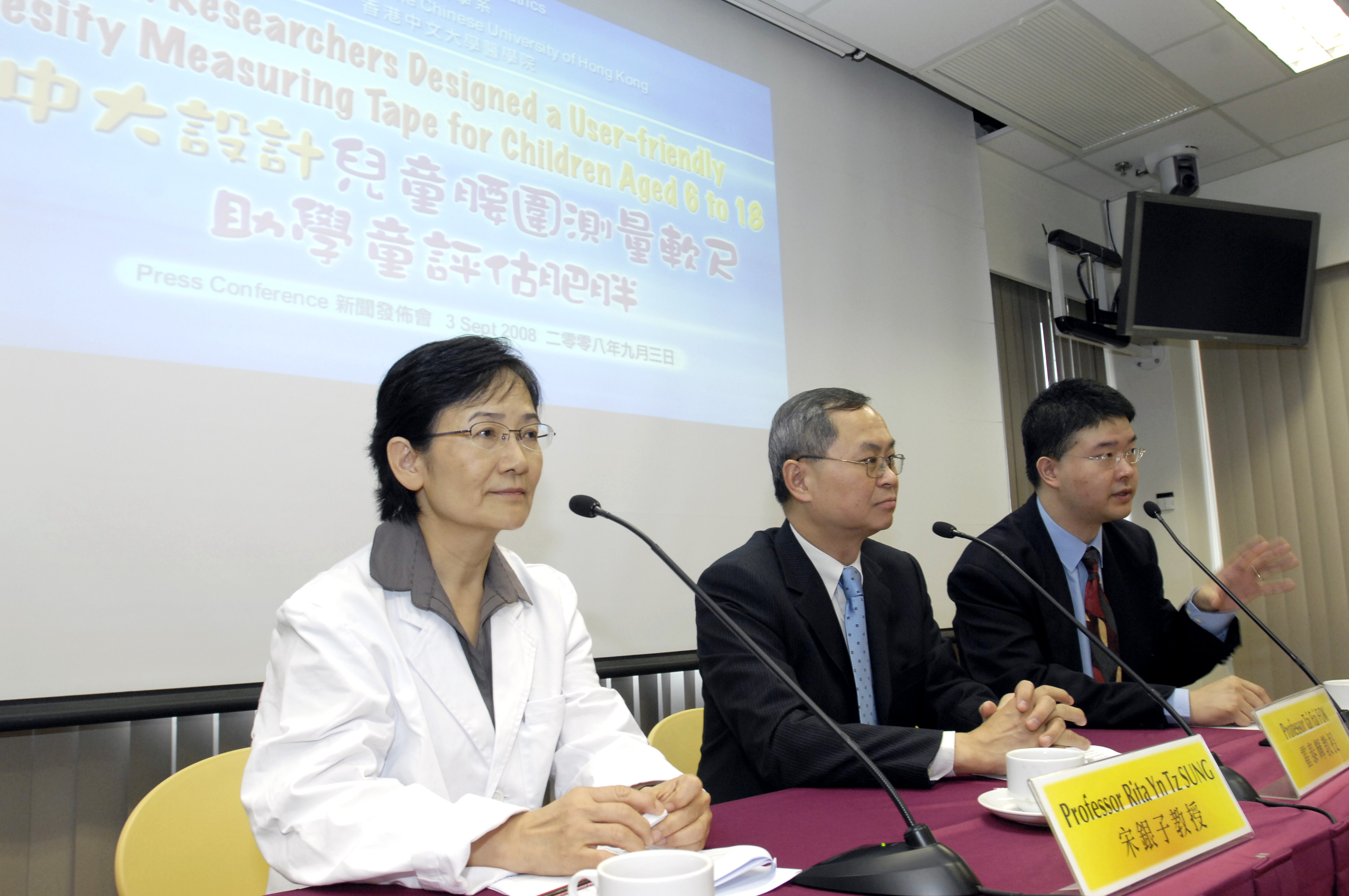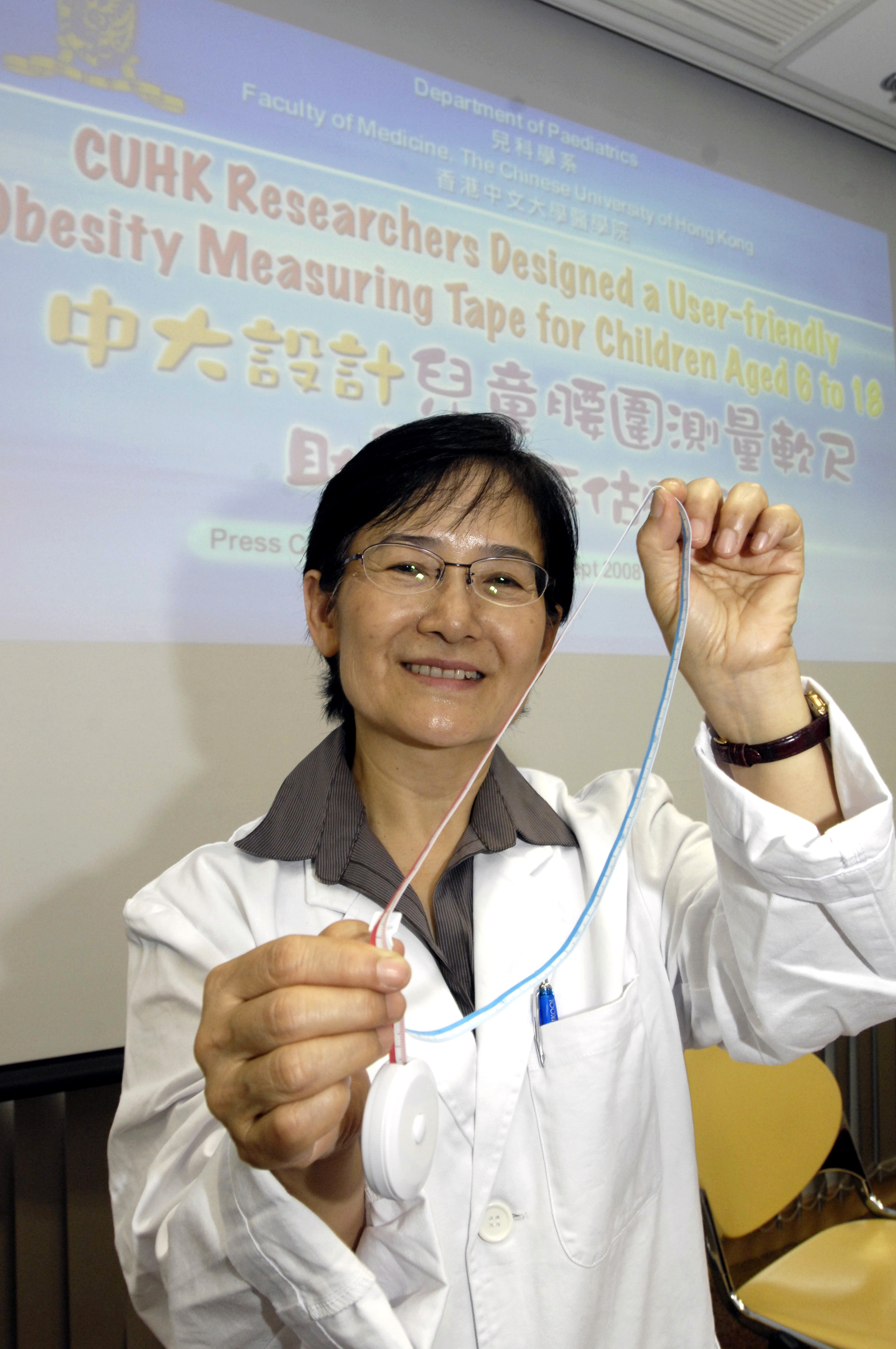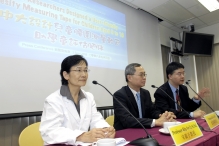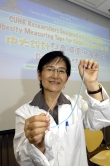CUHK
News Centre
CUHK Designs a User-friendly Obesity Measuring Tape for Children Aged 6 to 18
The prevalence of obesity has increased rapidly in the past two decades in both industrialized and developing countries. For the evaluation and management of obesity, a simple and clear definition of obesity is indispensable. So far, the most widely used definition of obesity is based on Body Mass Index (BMI) [weight (kg) /height² (m²)]. If an adult’s BMI is ≥ 25, he/she will be classified as overweight, while a BMI ≥ 30 is classified as obese. For children, no simple magic figures can be used. This is because a child’s BMI changes substantially with age, rising steeply in infancy, falling during the preschool years and rising again during childhood and adolescence. Hence, a child’s BMI needs to be assessed using age-related reference curves or tables.
Obesity is associated with clustering of cardiovascular (CV) risk factors – insulin resistance, dyslipidaemia and hypertension – empirically recognized as the “Metabolic Syndrome”. Metabolic syndrome occurs in obese children and tends to track into adult life. It appears to be related specifically to intra-abdominal fat (visceral adipose tissue) of which waist circumference (WC) provides a good and clinically useful measure. Growing evidence has shown that both BMI and WC correlate well (r = 0.93 for boys and 0.91 for girls) with CV factors.
The Department of Paediatrics at The Chinese University of Hong Kong (CUHK) has been conducting research in childhood obesity over the past decade and had established reference standards for WC and BMI in Hong Kong Chinese children. It was confirmed that high WC and BMI levels are associated with clusters of CV risk factors and the cut-off values of WC and BMI for predicting high risk patients have been worked out. In practice, however, it is highly inconvenient for health practitioners to use the cut-off values for WC and BMI as additional tables or curves are needed to be referred to.
In 2005/06 academic year, a team of 8 trained research staff from the Department of Paediatrics of CUHK collected the anthropometric data from 14,842 children aged 6 to 18 selected randomly from all the primary and secondary schools in Hong Kong. Descriptive statistics for each whole-year age group were calculated separately for each gender (see the table). Smoothed sex- and age-specific WC percentiles for the 3rd, 5th, 10th, 25th, 50th, 75th, 90th, 95th and 97th percentiles were developed. Boys had larger WC values than girls at every age-specific percentile and the differences became wider with increasing age (from 2cm at 6 years old to 6cm at 18 years old). The WC cut-off values for predicting high CV risk in Hong Kong Chinese children aged 6 – 18 years old were set at the 95th percentiles of the present WC standards. This WC threshold is likely to identify children at significant risk for obesity-related co-morbidities.
With these research findings, the Department of Paediatrics of CUHK designed a measuring tape for WC with clear marks on the cut-off values for each different age (6-18 years) for boys and girls. WC is measured midway between the lowest rib and the superior border of the iliac crest. This user friendly tape can also be used by schools or at homes for better understanding of the child obesity. This will save the trouble of painstaking BMI calculations and the use of extra reference tables.
The Hong Kong Professional Teachers’ Union (HKPTU) will organize seminars for teachers of primary and secondary schools to educate them on childhood obesity, and how to use the specially designed tape for measuring children’s waists. The measuring tapes will be made available for all schools at HKPTU’s service centres. The public will be able to participate in the programme by buying measuring tapes at $12 each from October 15 at the CUHK Souvenir Counter, located on the Ground Floor, John Fulton Centre, CUHK main campus, Shatin. (Enquiries: 2609-7886)
Sample sizes and mean and standard deviations (s.d.) for weight, height, BMI
and waist circumference for Hong Kong Chinese children aged 6-18 y
|
Sex |
Age |
N |
Weight (kg) |
Height (cm) |
BMI |
W C (cm) |
|
Boys |
6 |
402 |
23.9 (4.7) |
120.4 (5.5) |
16.2 (2.4) |
53.7 (5.4) |
|
|
7 |
520 |
26.4 (6.1) |
125.7 (5.9) |
16.6 (2.7) |
55.4 (6.6) |
|
|
8 |
572 |
29.3 (6.7) |
130.7 (5.9) |
17.0 (2.9) |
56.9 (6.8) |
|
|
9 |
629 |
32.7 (7.8) |
135.6 (6.0) |
17.6 (3.2) |
59.5 (7.8) |
|
|
10 |
627 |
37.5 (9.6) |
141.2 (6.9) |
18.7 (3.7) |
62.4 (9.1) |
|
|
11 |
644 |
41.8 (10.6) |
147.3 (7.9) |
19.1 (3.7) |
64.0 (9.2) |
|
|
12 |
729 |
46.6 (11.9) |
154.1 (8.6) |
19.4 (3.7) |
64.6 (9.1) |
|
|
13 |
657 |
51.1 (11.3) |
161.2 (7.9) |
19.6 (3.5) |
65.2 (8.2) |
|
|
14 |
632 |
54.9 (10.9) |
166.3 (6.9) |
19.8 (3.4) |
66.0 (7.7) |
|
|
15 |
558 |
59.1 (12.0) |
169.8 (5.4) |
20.4 (3.8) |
68.1 (8.7) |
|
|
16 |
579 |
60.6 (11.1) |
170.9 (5.8) |
20.7 (3.4) |
68.8 (8.2) |
|
|
17 |
553 |
61.5 (11.0) |
171.9 (5.7) |
20.8 (3.4) |
69.4 (7.8) |
|
|
18 |
370 |
62.3 (11.0) |
171.7 (5.6) |
21.1 (3.3) |
70.1 (7.6) |
|
Girls |
6 |
377 |
21.8 (3.8) |
118.7 (5.1) |
15.4 (1.9) |
51.3 (4.2) |
|
|
7 |
479 |
24.9 (5.1) |
124.2 (5.5) |
16.0 (2.5) |
53.3 (5.4) |
|
|
8 |
504 |
27.8 (6.0) |
129.9 (6.3) |
16.3 (2.5) |
54.6 (5.8) |
|
|
9 |
590 |
30.8 (6.4) |
135.1 (6.3) |
16.8 (2.6) |
56.7 (6.0) |
|
|
10 |
584 |
35.3 (8.5) |
141.7 (7.0) |
17.4 (3.1) |
58.5 (7.0) |
|
|
11 |
599 |
40.1 (9.3) |
148.9 (7.0) |
19.0 (3.2) |
60.2 (6.9) |
|
|
12 |
750 |
44.1 (9.4) |
153.1 (6.2) |
18.7 (3.3) |
61.2 (7.0) |
|
|
13 |
637 |
47.8 (8.5) |
156.2 (5.4) |
19.6 (3.1) |
62.2 (6.5) |
|
|
14 |
656 |
49.0 (8.6) |
157.6 (5.4) |
19.7 (3.0) |
62.3 (6.2) |
|
|
15 |
600 |
50.5 (9.1) |
158.3 (5.3) |
20.1 (3.3) |
63.0 (6.7) |
|
|
16 |
640 |
50.7 (8.9) |
158.3 (5.3) |
20.2 (3.3) |
63.2 (6.4) |
|
|
17 |
568 |
51.4 (9.2) |
158.9 (6.7) |
20.3 (3.3) |
63.5 (6.3) |
|
|
18 |
386 |
51.3 (8.1) |
158.6 (5.6) |
20.4 (2.9) |
63.8 (5.6) |
Age: complete age, e.g. 6y = 6.00-6.99y; WC: waist circumference
From left: Professor Rita Yn Tz Sung, Professor, Department of Paediatrics, CUHK Professor Tai Fai Fok, Dean & Professor of Paediatrics, Faculty of Medicine, CUHK Professor Albert Martin Li, Professor, Department of Paediatrics, CUHK





